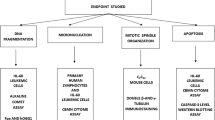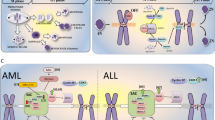Abstract
The leukemia cell line HL60 is widely used in studies of the cell cycle, apoptosis, and adhesion mechanisms in cancer cells. We conducted a focused cytogenetic study in an HL60 cell line, by analyzing GTG-banded chromosomes before and after treatment with pisosterol (at 0.5, 1.0, and 1.8 μg/ml), a triterpene isolated from Pisolithus tinctorius, a fungus collected in the Northeast of Brazil. Before treatment, 99% of the cells showed the homogeneously staining region (HSR) 8q24 aberration. After treatment with 1.8 μg/ml pisosterol, 90% of the analyzed cells lacked this aberration. We further performed a pulse test, in which the cells treated with pisosterol (0.5, 1.0, and 1.8 μg/ml) were washed and re-incubated in the absence of pisosterol. Only 30% of the analyzed cells lacked the HSR 8q24 aberration, suggesting that pisosterol probably blocks the cells with HSRs at interphase. No effects were detected at lower concentrations. At the highest concentration examined (1.8 μg/ml), pisosterol also inhibited cell growth, but this effect was not observed in the pulse test, reinforcing our hypothesis that, at the concentrations tested, pisosterol probably does not induce cell death in the HL60 line. The results found for pisosterol were compared with those for doxorubicin. Cells that do not show a high degree of gene amplification (HSRs and double-minute chromosomes) have a less aggressive and invasive behavior and are easy targets for chemotherapy. Therefore, further studies are needed to examine the use of pisosterol in combination with conventional anti-cancer therapy.


Similar content being viewed by others
Abbreviations
- ABR:
-
abnormally banded region
- HSR:
-
homogeneously staining region
- DMs:
-
double-minute chromosomes
- CGH:
-
comparative genomic hybridization
- MI:
-
mitotic index
- ISCN:
-
International System for Human Cytogenetic Nomenclature
- IC50 :
-
half inhibitory concentration
References
Benner SE, Wahl GM, Von Hoff DD. Double minute chromosomes and homogeneously staining regions in tumors taken directly from patients versus in human tumor cell lines. Anticancer Drugs. 1991;2:11–25.
Birnie GD. The HL60 cell line: a model system for studying human myeloid cell differentiation. Br J Cancer Suppl. 1988;9:41–5.
Burbano RR, Assumpção PP, Leal MF, Calcagno DQ, Guimarães AC, Khayat AS, et al. C-MYC locus amplification as metastasis predictor in intestinal-type gastric adenocarcinomas: CGH study in Brazil. Anticancer Res. 2006;26:2909–14.
Calcagno DQ, Leal MF, Taken SS, Assumpcao PP, Demachki S, Smith MA, et al. Aneuploidy of chromosome 8 and C-MYC amplification in individuals from northern Brazil with gastric adenocarcinoma. Anticancer Res. 2005;25:4069–74.
Calcagno DQ, Leal MF, Seabra AD, Khayat AS, Chen ES, Demachki S, et al. Interrelationship between chromosome 8 aneuploidy, C-MYC amplification and increased expression in individuals from northern Brazil with gastric adenocarcinoma. World J Gastroenterol. 2006;12:6207–11.
Carroll SM, DeRose ML, Gaudray P, Moore CM, Needham-VanDevanter DR, Von Hoff DD, et al. Double minute chromosomes can be produced from precursors derived from a chromosomal deletion. Mol Cell Biol. 1988;8:1525–33.
Collins SJ. The HL-60 promyelocytic leukemia cell line: Proliferation, differentiation, and cellular oncogene expression. Blood. 1987;70:1233–44.
Cottier M, Tchirkov A, Perissel B, Giollant M, Campos L, Vago P. Cytogenetic characterization of seven human cancer cell lines by combining G- and R-banding, -FISH, CGH and chromosome- and locus-specific FISH. Int J Mol Med. 2004;14(4):483–95.
Dang CV. c-Myc target genes involved in cell growth, apoptosis, and metabolism. Mol Cell Biol. 1999;19:1–11.
Dhawan MA, Kayani JM, Parry E, Anderson P. Aneugenic and clastogenic effects of doxorubicin in human lymphocytes. Mutagenesis. 2003;18:487–90.
Eckhardt SG, Dai A, Davidson KK, Forseth BJ, Wahl GM, Von Hoff DD. Induction of differentiation in HL60 cells by the reduction of extrachromosomally amplified c-myc. Proc Natl Acad Sci U S A. 1994;91:6674–8.
Escot C, Theillet C, Lidereau R, Spyratos F, Champeme MH, Gest J, et al. Genetic alteration of the c-myc protooncogene (MYC) in human primary breast carcinomas. Proc Natl Acad Sci U S A. 1986;83:4834–8.
Fegan CD, White D, Sweeney M. C-myc amplification, double minutes and homogenous staining regions in a case of AML. Br J Haematol. 1995;90:486–8.
Feo S, Di Liegro C, Mangano R, Read M, Fried M. The amplicons in HL60 cells contain novel cellular sequences linked to MYC locus DNA. Oncogene. 1996;13:1521–9.
Fischkoff SA, Pollak A, Gleich GJ, Testa JR, Misawa S, Reber TJ. Eosinophilic differentiation of the human promyelocytic leukemia cell line, HL-60. J Exp Med. 1984;160:179–96.
Gallagher R, Collins S, Trujillo J, McCredie K, Ahearn M, Tsai S, et al. Characterization of the continuous, differentiating myeloid cell line (HL-60) from a patient with acute promyelocytic leukemia. Blood. 1979;54:713–33.
Leglise MC, Dent GA, Ayscue LH, Ross DW. Leukemic cell maturation: phenotypic variability and oncogene expression in HL60 cells: a review. Blood Cells. 1988;13:319–37.
Lima PD, Leite DS, Vasconcellos MC, Cavalcanti BC, Santos RA, Costa-Lotufo LV, Pessoa C, Moraes MO, Burbano RR. Genotoxic effects of aluminum chloride in cultured human lymphocytes treated in different phases of cell cycle. Food Chem Toxicol. 2007a;45:1154–9.
Lima PD, Vasconcellos MC, Bahia MO, Montenegro RC, Pessoa CO, Costa-Lotufo LV, Moraes MO, Burbano RR. Genotoxic and cytotoxic effects of manganese chloride in cultured human lymphocytes treated in different phases of cell cycle. Toxicol In Vitro. 2007b;22:1032–7.
Lima PD, Vasconcellos MC, Montenegro RA, Sombra CM, Bahia MO, Costa-Lotufo LV, Pessoa CO, Moraes MO, Burbano RR. Genotoxic and cytotoxic effects of iron sulfate in cultured human lymphocytes treated in different phases of cell cycle. Toxicol In Vitro. 2008;22:723–9.
Little CD, Nau MM, Carney DN, Gazdar AF, Minna JD. Amplification and expression of the c-myc oncogene in human lung cancer cell lines. Nature. 1983;306:194–6.
Misawa S, Staal SP, Testa JR. Amplification of the c-myc oncogene is associated with an abnormally banded region on chromosome 8 or double minute chromosomes in two HL-60 human leukemia sublines. Cancer Genet Cytogenet. 1987;28(1):127–35.
Mitelman F, editor. ISCN. Guidelines for Cancer Cytogenetics. Supplement to: An International System for Human Cytogenetic Nomenclature. Switzerland: Karger; 1995.
Montenegro RC, Jimenez PC, Feio Farias RA, Andrade-Neto M, Silva Bezerra F, Moraes ME, et al. Cytotoxic activity of pisosterol, a triterpene isolated from Pisolithus tinctorius (Mich.: Pers.) Coker & Couch, 1928. Z Naturforsch [C]. 2004;59:519–22.
Montenegro RC, Vasconcellos MC, Bezerra FS, Andrade-Neto M, Pessoa C, Moraes MO, et al. Pisosterol induces monocytic differentiation in HL-60 cells. Toxicol in vitro. 2007;21:795–800.
Nowell P, Finan J, Dalla-Favera R, Gallo RC, ar-Rushdi A, Romanczuk H, et al. Association of amplified oncogene c-myc with an abnormally banded chromosome 8 in a human leukaemia cell line. Nature. 1983;306:494–7.
Scheres VMJC. Identification of two Robertsonian translocations with a Giemsa-banding technique. Human Genet. 1972;15:253–6.
Ulger C, Toruner GA, Alkan M, Mohammed M, Damani S, Kang J, et al. Comprehensive genome-wide comparison of DNA and RNA level scan using microarray technology for identification of candidate cancer-related genes in the HL-60 cell line. Cancer Genet Cytogenet. 2003;147:28–35.
Volpi EV, Vatcheva R, Labella T, Gan SU. More detailed characterization of some of the HL60 karyotypic features by fluorescence in situ hybridization. Cancer Genet Cytogenet. 1996;87:103–6.
Von Hoff DD, Needham-VanDevanter DR, Yucel J, Windle BE, Wahl GM. Amplified human MYC oncogenes localized to replicating submicroscopic circular DNA molecules. Proc Natl Acad Sci U S A. 1988;85:4804–8.
Von Hoff DD, Forseth B, Clare CN, Hansen KL, VanDevanter D. Double minutes arise from circular extrachromosomal DNA intermediates which integrate into chromosomal sites in human HL-60 leukemia cells. J Clin Invest. 1990;85:1887–95.
Von Hoff DD, McGill JR, Forseth BJ, Davidson KK, Bradley TP, Van Devanter DR, et al. Elimination of extrachromosomally amplified MYC genes from human tumor cells reduces their tumorigenicity. Proc Natl Acad Sci U S A. 1992;89:8165–9.
Wang ZR, Liu W, Smith ST, Parrish RS, Young SR. C-myc and chromosome 8 centromere studies of ovarian cancer by interphase FISH. Exp Mol Pathol. 1999;66:140–8.
Wessendorf S, Fritz B, Wrobel G, Nessling M, Lampel S, Goettel D, et al. Automated screening for genomic imbalances using matrix-based comparative genomic hybridization. Lab Invest. 2002;82:47–60.
Wolman SR, Lanfrancone L, Dalla-Favera R, Ripley S, Henderson AS. Oncogene mobility in a human leukemia line HL-60. Cancer Genet Cyfstogenet. 1985;17(2):133–41.
Yunis JJ. New chromosome techniques in the study of human neoplasia. Human Pathol. 1981;12:540–9.
Acknowledgments
This work was supported by Conselho Nacional de Desenvolvimento Científico e Tecnológico (CNPq) grant No. 409826/2006-5. RRB had a PQ-2 fellowship (number 308256/2006-9) granted by CNPq. We wish to thank CAPES, FUNCAP, FINEP, BNB/FUNDECI, and PRONEX for financial support in the form of grants and fellowship awards. We are grateful to Dr. A. Leyva who provided English editing of the manuscript.
Author information
Authors and Affiliations
Corresponding author
Rights and permissions
About this article
Cite this article
Burbano, R.R., Lima, P.D.L., Bahia, M.O. et al. Cell cycle arrest induced by Pisosterol in HL60 cells with gene amplification. Cell Biol Toxicol 25, 245–251 (2009). https://doi.org/10.1007/s10565-008-9074-x
Received:
Accepted:
Published:
Issue Date:
DOI: https://doi.org/10.1007/s10565-008-9074-x




